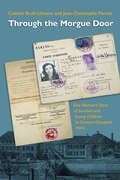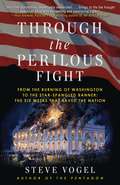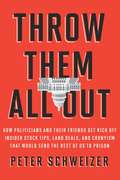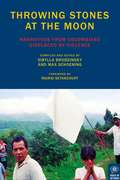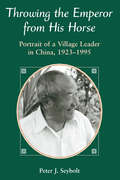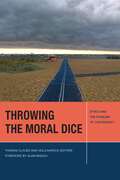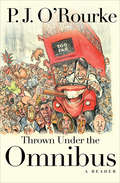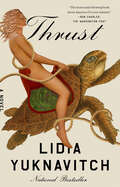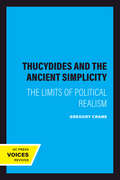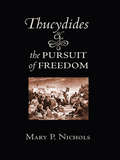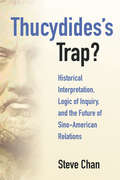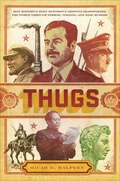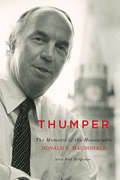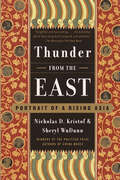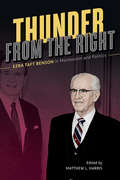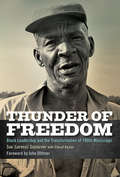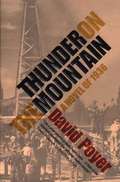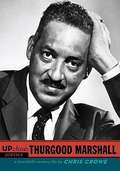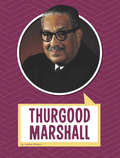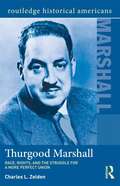- Table View
- List View
Through the Morgue Door: One Woman’s Story of Survival and Saving Children in German-Occupied Paris (Pennsylvania Studies in Human Rights)
by Colette Brull-Ulmann Jean-Christophe PortesIn 1934, at the age of fourteen, Colette Brull-Ulmann knew that she wanted to become a pediatrician. By the age of twenty-one, she was in her second year of studying medicine. By 1942, Brull-Ulman and her family had become registered Jews under the ever-increasing statutes against them enacted by Petain’s government. Her father had been arrested and interned at the Drancy detention camp and Brull-Ulman had become an intern at the Rothschild Hospital, the only hospital in Paris where Jewish physicians were allowed to practice and Jewish patients could go for treatment.Under Claire Heyman, a charismatic social worker who was a leader of the hospital’s secret escape network, Brull-Ulmann began working tirelessly to rescue Jewish children treated at the Rothschild. Her devotion to the protection of children, her bravery, and her imperviousness in the face of the deadly injustices of the Holocaust were always evident—whether smuggling children to safety through the Paris streets in the dead of night or defying officers and doctors who frighteningly held her fate in their hands. Ultimately, Brull-Ulmann was forced to flee the Rothschild in 1943, when she joined her father’s resistance network, gathering and delivering information for De Gaulle’s secret intelligence agency until the Liberation in 1945.In 1970, Brull-Ulmann finally became a licensed pediatrician. But after the war, like so many others, she sought to bury her memories. It wasn’t until decades later when she finally started to speak publicly—not only about her own work and survival, but about the one child who affected her most deeply. Originally published in French in 2017, Brull-Ulmann’s memoir fearlessly illustrates the horrors of Jewish life under the German Occupation and casts light on the heretofore unknown story of the Rothschild Hospital during this period. But most of all, it chronicles the life of a truly exceptional and courageous woman for whom not acting was never an option.
Through the Perilous Fight: Six Weeks That Saved the Nation
by Steve VogelIn a rousing account of one of the critical turning points in American history, Through the Perilous Fight tells the gripping story of the burning of Washington and the improbable last stand at Baltimore that helped save the nation and inspired its National Anthem. In the summer of 1814, the United States of America teetered on the brink of disaster. The war it had declared against Great Britain two years earlier appeared headed toward inglorious American defeat. The young nation's most implacable nemesis, the ruthless British Admiral George Cockburn, launched an invasion of Washington in a daring attempt to decapitate the government and crush the American spirit. The British succeeded spectacularly, burning down most of the city's landmarks--including the White House and the Capitol--and driving President James Madison from the area. As looters ransacked federal buildings and panic gripped the citizens of Washington, beleaguered American forces were forced to regroup for a last-ditch defense of Baltimore. The outcome of that "perilous fight" would help change the outcome of the war--and with it, the fate of the fledgling American republic. In a fast-paced, character-driven narrative, Steve Vogel tells the story of this titanic struggle from the perspective of both sides. Like an epic novel, Through the Perilous Fight abounds with heroes, villains, and astounding feats of derring-do. The vindictive Cockburn emerges from these pages as a pioneer in the art of total warfare, ordering his men to "knock down, burn, and destroy" everything in their path. While President Madison dithers on how to protect the capital, Secretary of State James Monroe personally organizes the American defenses, with disastrous results. Meanwhile, a prominent Washington lawyer named Francis Scott Key embarks on a mission of mercy to negotiate the release of an American prisoner. His journey will place him with the British fleet during the climactic Battle for Baltimore, and culminate in the creation of one of the most enduring compositions in the annals of patriotic song: "The Star-Spangled Banner." Like Pearl Harbor or 9/11, the burning of Washington was a devastating national tragedy that ultimately united America and renewed its sense of purpose. Through the Perilous Fight combines bravura storytelling with brilliantly rendered character sketches to recreate the thrilling six-week period when Americans rallied from the ashes to overcome their oldest adversary--and win themselves a new birth of freedom.Advance praise for Through the Perilous Fight "Vogel . . . superbly dramatizes a campaign whose legacy is 'The Star-Spangled Banner,' both the anthem and the flag for which it stands, today displayed in Washington."--Booklist "The experienced author knows how to write about the military and its human and martial conflicts. . . . A swift, vibrant account of the accidents, intricacies and insanities of war."--Kirkus Reviews"Very fine storytelling, impeccably researched . . . Through the Perilous Fight brings to life the fraught events of 1814 with compelling and convincing vigor."--Rick Atkinson, Pulitzer Prize-winning author of An Army at Dawn "Before 9/11 was 1814--the year the enemy burned the nation's capital. Steve Vogel gives a splendid account, fast-paced and detailed, of the uncertainty, the peril, and the valor of those days."--Richard Brookhiser, author of James MadisonFrom the Hardcover edition.
Throw Them All Out
by Peter SchweizerPoliticians often come into office with relatively modest assets. As investors, they regularly beat the market and sometimes beat the most rapacious hedge funds. Even without making stock trades, they often retire rich. How do they do it?Billionaires and hedge fund managers often make well-timed investment decisions that anticipate events in Washington. How do they do it?When such former politicians and federal appointees as Al Gore, Dan Quayle, and Madeleine Albright decide to launch investment funds, wealthy clients sign up. Why?Welcome to the insidious world of crony capitalism.Cronyism exists not so much as outright bribery, using suitcases full of cash, but rather in accepted insider routes to wealth: Members of Congress trade stocks based on privileged information. They insert earmarks into bills to improve their own real estate holdings. Campaign contributors receive billions in federal grants. Nobody goes to jail.Crony capitalism transcends party lines and has become a big business hidden in plain sight. Using personal financial information, government databases, and a team of indefatigable researchers, Peter Schweizer shines a light into the darkest corners of the system -- and offers ways to overcome it. It is time to clean house.
Throw Them All Out: How Politicians and Their Friends Get Rich Off Insider Stock Tips, Land Deals, and Cronyism That Wou
by Peter SchweizerTHE BOOK WASHINGTON DOES NOT WANT YOU TO READHow is it that politicians often enter office with relatively modest assets, but then, as investors, regularly beat the stock market and sometimes beat the most rapacious hedge funds? How did some members of Congress know to dump their stock holdings just in time to escape the effects of the 2008 financial meltdown? And how is it that billionaires and hedge fund managers often make well-timed investment decisions that anticipate events in Washington? In this powerfully argued book, Peter Schweizer blows the lid off Washington's epidemic of "honest graft." He exposes a secret world where members of Congress insert earmarks into bills to improve their own real-estate holdings, and campaign contributors receive billions in federal grants. Nobody goes to jail. Throw Them All Out casts light into the darkest corners of the political system -- and offers ways to clean house."Throw Them All Out is filled with stories of petty theft and so-called 'honest graft' . . . Unsparingly bipartisan in [its] criticism of Washington . . . Mr. Schweizer has performed a valuable service to his country." -- Washington Times
Throw Them All Out: How Politicians and Their Friends Get Rich Off Insider Stock Tips, Land Deals, and Cronyism That Wou
by Peter SchweizerTHE BOOK WASHINGTON DOES NOT WANT YOU TO READHow is it that politicians often enter office with relatively modest assets, but then, as investors, regularly beat the stock market and sometimes beat the most rapacious hedge funds? How did some members of Congress know to dump their stock holdings just in time to escape the effects of the 2008 financial meltdown? And how is it that billionaires and hedge fund managers often make well-timed investment decisions that anticipate events in Washington? In this powerfully argued book, Peter Schweizer blows the lid off Washington’s epidemic of “honest graft.” He exposes a secret world where members of Congress insert earmarks into bills to improve their own real-estate holdings, and campaign contributors receive billions in federal grants. Nobody goes to jail. Throw Them All Out casts light into the darkest corners of the political system — and offers ways to clean house."Throw Them All Out is filled with stories of petty theft and so-called 'honest graft' . . . Unsparingly bipartisan in [its] criticism of Washington . . . Mr. Schweizer has performed a valuable service to his country." — Washington Times
Throw Them All Out: How Politicians and Their Friends Get Rich Off Insider Stock Tips, Land Deals, and Cronyism That Wou
by Peter SchweizerTHE BOOK WASHINGTON DOES NOT WANT YOU TO READHow is it that politicians often enter office with relatively modest assets, but then, as investors, regularly beat the stock market and sometimes beat the most rapacious hedge funds? How did some members of Congress know to dump their stock holdings just in time to escape the effects of the 2008 financial meltdown? And how is it that billionaires and hedge fund managers often make well-timed investment decisions that anticipate events in Washington? In this powerfully argued book, Peter Schweizer blows the lid off Washington’s epidemic of “honest graft.” He exposes a secret world where members of Congress insert earmarks into bills to improve their own real-estate holdings, and campaign contributors receive billions in federal grants. Nobody goes to jail. Throw Them All Out casts light into the darkest corners of the political system — and offers ways to clean house."Throw Them All Out is filled with stories of petty theft and so-called 'honest graft' . . . Unsparingly bipartisan in [its] criticism of Washington . . . Mr. Schweizer has performed a valuable service to his country." — Washington Times
Throwing Stones at the Moon
by Sibylla Brodzinsky Max SchoeningFor nearly five decades, Colombia has been embroiled in internal armed conflict among guerrilla groups, paramilitary militias, and the country's own military. Civilians in Colombia have to make their lives despite the threat of torture, kidnapping, and large-scale massacres-and more than four million have had to flee their homes. The oral histories in Throwing Stones at the Moon describe the most widespread of Colombia's human rights crises: forced displacement. Speakers recount life before displacement, the reasons for their flight, and their struggle to rebuild their lives. Among the narrators:JULIA, a hospital union leader whose fight against corruption led to a brutal attempt on her life. In 2009, assassins tracked her to her home and stabbed her seven times in the face and chest. Since the attack, Julia has undergone eight facial reconstructive surgeries, and continues to live in hiding.DANNY, who at eighteen joined a right-wing paramilitary's enormous training camp in the Eastern Plains of Colombia. Initially lured by the promise of quick money, Danny soon realized his mistake and escaped to Ecuador. He describes his harrowing escape and his struggle to survive as a refugee with two young children to support.
Throwing The Emperor From His Horse: Portrait Of A Village Leader In China, 1923-1995
by Peter J SeyboltThis engaging book sketches an intimate portrait of the life of Wang Fucheng, an illiterate peasant who served for thirty years as Communist party secretary of an impoverished village on the north China plain. Based on conversations over a seven-year period (1987 - 1994) between Wang Fucheng and Peter Seybolt, the book unfolds as a continuous first
Throwing the Moral Dice: Ethics and the Problem of Contingency (Just Ideas)
by Thomas Claviez and Viola MarchiMore than a purely philosophical problem, straddling the ambivalent terrain between necessity and impossibility, contingency has become the very horizon of everyday life. Often used as a synonym for the precariousness of working conditions under neoliberalism, for the unknown threats posed by terrorism, or for the uncertain future of the planet itself, contingency needs to be calculated and controlled in the name of the protection of life. The overcoming of contingency is not only called upon to justify questionable mechanisms of political control; it serves as a central legitimating factor for Enlightenment itself. In this volume, nine major philosophers and theorists address a range of questions around contingency and moral philosophy. How can we rethink contingency in its creative aspects, outside the dominant rhetoric of risk and dangerous exposure? What is the status of contingency—as the unnecessary and law-defying—in or for ethics? What would an alternative “ethics of contingency”—one that does not simply attempt to sublate it out of existence—look like?The volume tackles the problem contingency has always posed to both ethical theory and dialectics: that of difference itself, in the difficult mediation between the particular and the universal, same and other, the contingent singularity of the event and the necessary generality of the norms and laws.From deconstruction to feminism to ecological thought, some of today’s most influential thinkers reshape many of the most debated concepts in moral philosophy: difference, agency, community, and life itself.Contributors: Étienne Balibar, Rosi Braidotti, Thomas Claviez, Drucilla Cornell, Hans Ulrich Gumbrecht, Viola Marchi, Michael Naas, Cary Wolfe, Slavoj Žižek
Thrown Under the Omnibus: A Reader
by P. J. O'RourkeAn essential collection of career-spanning writings by the political satirist and #1 New York Times–bestselling author of Parliament of Whores. From his early pieces for the National Lampoon, through his classic reporting as Rolling Stone&’s International Affairs editor in the 1980s and 1990s, and his brilliant, inimitable political journalism and analysis, P. J. O&’Rourke has been entertaining and provoking readers with high octane prose, a gonzo Republican attitude, and a rare ability to make you laugh out loud. Christopher Buckley once described his work as &“S. J. Perelman on acid.&” Thrown Under the Omnibus brings together his funniest, most outrageous, most controversial, and most loved pieces in the definitive O&’Rourke reader. Handpicked and introduced by the humorist himself, Thrown Under the Omnibus is the essential O&’Rourke anthology. &“The funniest writer in America.&” —The Wall Street Journal
Thrust: A Novel
by Lidia YuknavitchTHRUST IS:&“Epic.&” –The New York Times &“A triumph.&” —Elle &“Stunningly beautiful.&” —The Daily Beast &“Both of the moment and utterly timeless.&” —Chicago Review of Books &“A book to take in wide-eyed.&” —Rebecca MakkaiNAMED A BEST BOOK OF THE SUMMER BY TIME, THE LOS ANGELES TIMES, ELLE, THE DAILY BEAST, BUSTLE, LITHUB, and GIZMODOAs rising waters—and an encroaching police state—endanger her life and family, a girl with the gifts of a "carrier" travels through water and time to rescue vulnerable figures from the margins of historyLidia Yuknavitch has an unmatched gift for capturing stories of people on the margins—vulnerable humans leading lives of challenge and transcendence. Now, Yuknavitch offers an imaginative masterpiece: the story of Laisvė, a motherless girl from the late 21st century who is learning her power as a carrier, a person who can harness the power of meaningful objects to carry her through time. Sifting through the detritus of a fallen city known as the Brook, she discovers a talisman that will mysteriously connect her with a series of characters from the past two centuries: a French sculptor; a woman of the American underworld; a dictator's daughter; an accused murderer; and a squad of laborers at work on a national monument. Through intricately braided storylines, Laisvė must dodge enforcement raids and find her way to the present day, and then, finally, to the early days of her imperfect country, to forge a connection that might save their lives--and their shared dream of freedom. A dazzling novel of body, spirit, and survival, Thrust will leave no reader unchanged.
Thucydides and the Ancient Simplicity: The Limits of Political Realism
by Gregory CraneThucydides' History of the Peloponnesian War is the earliest surviving realist text in the European tradition. As an account of the Peloponnesian War, it is famous both as an analysis of power politics and as a classic of political realism. From the opening speeches, Thucydides' Athenians emerge as a new and frightening source of power, motivated by self-interest and oblivious to the rules and shared values under which the Greeks had operated for centuries. Gregory Crane demonstrates how Thucydides' history brilliantly analyzes both the power and the dramatic weaknesses of realist thought. The tragedy of Thucydides' history emerges from the ultimate failure of the Athenian project. The new morality of the imperialists proved as conflicted as the old; history shows that their values were unstable and self-destructive. Thucydides' history ends with the recounting of an intellectual stalemate that, a century later, motivated Plato's greatest work. Thucydides and the Ancient Simplicity includes a thought-provoking discussion questioning currently held ideas of political realism and its limits. Crane's sophisticated claim for the continuing usefulness of the political examples of the classical past will appeal to anyone interested in the conflict between the exercise of political power and the preservation of human freedom and dignity.
Thucydides and the Pursuit of Freedom
by Mary P. NicholsIn Thucydides and the Pursuit of Freedom, Mary P. Nichols argues for the centrality of the idea of freedom in Thucydides' thought. Through her close reading of his History of the Peloponnesian War, she explores the manifestations of this theme. Cities and individuals in Thucydides' history take freedom as their goal, whether they claim to possess it and want to maintain it or whether they desire to attain it for themselves or others. Freedom is the goal of both antagonists in the Peloponnesian War, Sparta and Athens, although in different ways. One of the fullest expressions of freedom can be seen in the rhetoric of Thucydides’ Pericles, especially in his famous funeral oration. More than simply documenting the struggle for freedom, however, Thucydides himself is taking freedom as his cause. On the one hand, he demonstrates that freedom makes possible human excellence, including courage, self-restraint, deliberation, and judgment, which support freedom in turn. On the other hand, the pursuit of freedom, in one’s own regime and in the world at large, clashes with interests and material necessity, and indeed the very passions required for its support. Thucydides’ work, which he himself considered a possession for all time, therefore speaks very much to our time, encouraging the defense of freedom while warning of the limits and dangers in doing so. The powerful must defend freedom, Thucydides teaches, but beware that the cost not become freedom itself.
Thucydides on Politics
by Geoffrey HawthornThucydides famously declared his work to be 'a possession for all time', and so it has proved to be, as each age and generation has seen new things to admire in it and take from it. In the last hundred years, Thucydides has been interpreted and invoked in support of many different positions in politics, political theory and international relations. Geoffrey Hawthorn offers a new and highly original reading, one that sees him as neither simply an ancestor nor a colleague but as an unsurpassed guide to a deeper realism about politics. In this account, Thucydides emerges as sensitive to the non-rational and the limits of human agency, sceptical about political speech, resistant to easy generalisations or theoretical reductions, and opposed to any practical, moral or constitutional closure in politics. The book will be of interest to students of politics and classics.
Thucydides’s Trap?: Historical Interpretation, Logic of Inquiry, and the Future of Sino-American Relations
by Steve ChanThe Peloponnesian War (431–404 BCE) ostensibly arose because of the fear that a rising Athens would threaten Sparta’s power in the Mediterranean. The idea of Thucydides’ Trap warns that all rising powers threaten established powers. As China increases its power relative to the United States, the theory argues, the two nations are inevitably set on a collision course toward war. How enlightening is an analogy based on the ancient Greek world of 2,500 years ago for understanding contemporary international relations? How accurate is the depiction of the history of other large armed conflicts, such as the two world wars, as a challenge mounted by a rising power to displace an incumbent hegemon?Thucydides’s Trap?: Historical Interpretation, Logic of Inquiry, and the Future of Sino-American Relations offers a critique of the claims of Thucydides’s Trap and power-transition theory. It examines past instances of peaceful accommodation to uncover lessons that can ease the frictions in ongoing Sino-American relations.
Thugs: How History's Most Notorious Despots Transformed the World through Terror, Tyranny, and Mass Murder
by Micah D. HalpernAn incisive look into the lives, politics, and horrible deeds of fifty-six of history’s most notorious world leaders—and how they shaped our world for the worst.For the most notorious leaders in the history of the world, evil is more than just a moment of weakness—it’s a way of life.For every noble king, righteous emperor, and peace-loving president, history seems to serve up a double portion of murderous pharaohs, deranged dictators, or corrupt czars. Thugs probes this dark and twisted side of raw human power—from France’s King Louis XIV to China’s Mao Tse-Tung and everywhere in between. It’s a fascinating peek into the lives of the rich and infamous, the sour crème de la crème.Some, like Herod the Great, earned villainous reputations for slaughtering their own family members and countrymen. Others, like Egypt’s King Farouk, were almost laughable in their misdeeds, amassing the world’s largest collection of pornography. Then there are those leaders, such as Hitler, who committed acts of such unspeakable evil that their names are uttered as curses.From Filipino first lady Imelda Marcos’s bullet-proof bras to African strongman Ide Amin’s bizarre fixation with all things Scottish, Micah D. Halpern turns the yellowed pages of history and contemporary news accounts to profile the bewildering, outrageous, horrific, gut-wrenching, zany, and tragicomic behavior of the world’s worst leaders.Praise for Thugs“Written in short, easy-to-digest sentences, columnist and historian Halpern fills his brief sketches with colorful, terrible details in the manner of that rare, beloved history teacher whose lectures stir rapture in a nap-prone student body.” —Publishers Weekly
Thumper: The Memoirs of the Honourable Donald S. Macdonald
by Rod Mcqueen Donald S. Macdonald"At a certain point in our lives we are left only with our close relationships and our clear recollections. " So begins Thumper: The Memoirs of the Honourable Donald S. Macdonald. An early supporter of Pierre Trudeau for the Liberal Party leadership, Donald Macdonald's career in public life spanned four decades and included posts as House leader, minister of national defence, minister of energy, and minister of finance. He chaired the landmark Royal Commission on the Economic Union and Development Prospects for Canada, which led to free trade between Canada and the United States, and as High Commissioner to the United Kingdom he conferred with Margaret Thatcher and dined with Queen Elizabeth II. Drawing on extensive archival resources and contemporaneous personal diaries, Macdonald insightfully details his friendship with Trudeau, fascinating encounters with world leaders, and personal revelations about the October Crisis. In this behind-the-scenes account of the business of governing, he also describes high-stakes disputes with Alberta over soaring energy prices, the real story behind the resignation of John Turner as finance minister, and the decisive action taken against inflation using wage and price controls. Interlaced with anecdotes that reveal Macdonald's self-effacing good-nature, Thumper is a riveting memoir written with humility and candour, recalling an exceptional period in Canadian politics.
Thumper: The Memoirs of the Honourable Donald S. Macdonald
by Donald S. Macdonald Rod McQueen"At a certain point in our lives we are left only with our close relationships and our clear recollections." So begins Thumper: The Memoirs of the Honourable Donald S. Macdonald. An early supporter of Pierre Trudeau for the Liberal Party leadership, Donald Macdonald has had a career in public life spanning four decades that included posts as House leader, minister of national defence, minister of energy, and minister of finance. He chaired the landmark Royal Commission on the Economic Union and Development Prospects for Canada, which led to free trade between Canada and the United States, and as High Commissioner to the United Kingdom he conferred with Margaret Thatcher and dined with Queen Elizabeth II. Drawing on extensive archival resources and contemporaneous personal diaries, Macdonald insightfully details his friendship with Trudeau, fascinating encounters with world leaders, and personal revelations about the October Crisis. In this behind-the-scenes account of the business of governing, he also describes high-stakes disputes with Alberta over soaring energy prices, the real story behind the resignation of John Turner as finance minister, and the decisive action taken against inflation using wage and price controls. Interlaced with anecdotes that reveal Macdonald's self-effacing good-nature, Thumper is a riveting memoir written with humility and candour, recalling an exceptional period in Canadian politics.
Thunder from the East
by Nicholas D. Kristof Sheryl WudunnKristof and WuDunn (Pulitzer-prize winning correspondents) depict a continent pregnant with potential and poised to reassert itself in the global era. Centering their analysis on the 1997 economic crisis, they consider the economic development of China, predict a renaissance in India, and discuss the role of technological innovation in Japan. They characterize the continent through the stories of people they have encountered: a Cambodian girl sold by her parents to a brothel; a bankrupted Thai businessman who started anew as a street vendor; a Japanese veteran haunted by the mother and child he killed during the war. They also consider Asia's shortcomings, such as the pervasive discrimination against women, the pollution accompanying development, and the rise of nationalism. Annotation c. Book News, Inc. , Portland, OR (booknews. com)
Thunder from the Right: Ezra Taft Benson in Mormonism and Politics
by Matthew L HarrisEzra Taft Benson's ultra-conservative vision made him one of the most polarizing leaders in the history of the Church of Jesus Christ of Latter-day Saints. His willingness to mix religion with extreme right-wing politics troubled many. Yet his fierce defense of the traditional family, unabashed love of country, and deep knowledge of the faith endeared him to millions. In Thunder from the Right, a group of veteran Mormon scholars probe aspects of Benson's extraordinary life. Topics include: how Benson's views influenced his actions as Secretary of Agriculture in the Eisenhower Administration; his dedication to the conservative movement, from alliances with Barry Goldwater and the John Birch Society to his condemnation of the civil rights movement as a communist front; how his concept of the principal of free agency became central to Mormon theology; his advocacy of traditional gender roles as a counterbalance to liberalism; and the events and implications of Benson's term as Church president. Contributors: Gary James Bergera, Matthew Bowman, Newell G. Bringhurst, Brian Q. Cannon, Robert A. Goldberg, Matthew L. Harris, J. B. Haws, and Andrea G. Radke-Moss
Thunder of Freedom: Black Leadership and the Transformation of 1960s Mississippi (Civil Rights and the Struggle for Black Equality in the Twentieth Century)
by Sue [Lorenzi] Sojourner Cheryl ReitanA veteran of the civil right movement recounts the events of Freedom Summer in Mississippi through oral histories, personal reflections and photos.The world's eyes were on Mississippi during the summer of 1964, when civil rights activists launched an ambitious African American voter registration project and were met with violent resistance from white supremacists. Sue Sojourner and her husband arrived in Holmes County, Mississippi, in the wake of this historic time, known as Freedom Summer.From September 1964 until her departure from the state in 1969, Sojourner collected an incredible number of documents, oral histories, and photographs chronicling the dramatic events she witnessed. In Thunder of Freedom, written with Cheryl Reitan, Sojourner presents a fascinating account of one of the civil rights movement's most active and broad-based community organizing operations in the South.Sojourner shares her personal experiences as well as insights into race relations in the 1960s South, providing a unique look at the struggle for rights and equality in Mississippi. Illustrated with selections from Sojourner's acclaimed catalog of photographs, this profound book tells the powerful, often intimate stories of ordinary people who accomplished extraordinary things.
Thunder on the Mountain (Hemlock County #4)
by David PoyerGoing back to the 1936 winter in Pennsylvania, the year a strike was organized for the workers in the Thunder Oil Company occurs after a refinery disaster shows the lack of workers safety. W.T. Halvorsen - a young boxer becomes a leader of the strike against Thunder's family company. The strike is recognized nationally which attracts unwanted attention. As disturbance spreads among many Halyorsen and Thunder have to put their feelings of honor and their ethics to the test to find out who is kin of the mountain.
Thurgood Marshall
by Chris CroweThurgood Marshall changed American history by challenging it. In the first half of the twentieth century, African Americans were often treated as second-class citizens and subject to ?Jim Crow? laws, which promoted both racism and segregation. This is the world that Marshall grew up in, and he became a lawyer to change it. As the head counsel for the National Association for the Advancement of Colored People (NAACP), he helped take the famous Brown v. Board of Education all the way to the U. S. Supreme Court. And in an outcome surprising even to him, the court unanimously ruled to end segregation in schools. Thurgood Marshall had become a hero.
Thurgood Marshall (Biographies)
by Lakita WilsonHow much do you know about Thurgood Marshall? Find out the facts you need to know about this civil rights lawyer and justice of the U.S. Supreme Court. You'll learn about the early life, challenges, and major accomplishments of this important American.
Thurgood Marshall: Race, Rights, and the Struggle for a More Perfect Union
by Charles L. ZeldenThurgood Marshall was an Associate Justice of the US Supreme Court from 1967 to 1991. He was the first African American to hold that position, and was one of the most influential legal actors of his time. Before being appointed to the Supreme Court by President Lyndon Johnson, Marshall was a lawyer for the National Association for the Advancement of Colored People (NAACP), Federal Judge (1961-1965), and Solicitor General of the United States (1965-1966). Marshall won twenty-nine of thirty-two cases before the Supreme Court – most notably the landmark case of Brown v. Board of Education, which held segregated public schools unconstitutional. Marshall spent his career fighting racial segregation and legal inequality, and his time on the court establishing a record for supporting the "voiceless American." He left a legacy of change that still affects American society today. Through this concise biography, accompanied by primary sources that present Marshall in his own words, students will learn what Marshall did (and did not do) during his life, why those actions were important, and what effects his efforts had on the larger course of American history.
